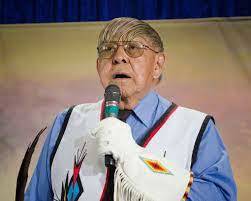The Continental Divide Trail (CDT) unites us. From Gateway Community residents to thru-travelers, and everyone in between, our diverse community is connected by our mission to protect the CDT. We are showcasing stories of the people and places that make up our community with our series, Voices of the CDT. Each month, look out for new stories that highlight these diverse experiences, histories, and faces, against the backdrop of the awe-inspiring Continental Divide.
INTERESTED IN SHARING YOUR CONNECTION TO THESE LANDSCAPES? SEND US YOUR STORY AT [email protected] FOR A CHANCE TO BE FEATURED!
Chief Earl Old Person
Storyteller, advocate, leader and community supporter.

Introduction
In honor of Native American Heritage Month, we’re highlighting Chief Earl Old Person, who was an incredible storyteller, advocate, leader and community supporter.
Old Person, who recently passed on October 13th, 2021, was chief of the Blackfeet Nation and served as chairman for 34 years.The Blackfeet Nation Reservation sits in the northwest part of Montana and is located just to the east of the Continental Divide Trail and Glacier National Park.
At the CDTC we strongly support the use of Land Acknowledgements as a start to expressing the gratitude and appreciation to the original stewards of the lands the CDT runs through. The lands that the CDT traverses are the lands of the Chiricahua Apache, Western Apache, Zuni, Pueblo, Dine, Jicarilla Apache Ute, Arapaho, Cheyenne, Eastern Shoshone (sho-sho-nee), Shoshone-Bannock, Lemhi Shoshone, Apsaalooke(Apsa-a-loke), Niitsitapi (Nitz-i-tapi), Salish Kootenai (Say-lish Koo-tnay), Ktunaxa (k-too-nah-ha), and Tsuu T’ina (chu’tina) peoples, along with the many other people and tribes that traveled and lived on these lands before colonization.
We at CDTC recognize that the traditional stewards of these places that have called them home for millennia, and still call them home today, were persecuted and killed through genocide and forced removal from these places. We honor these people, past, present and future, and all Indigenous peoples who inhabited, stewarded, and held sacred the land along the Continental Divide. The displacement of and violence against Native peoples is ongoing. Yet, at the same time, Native stewardship and relationship with the land also continues.
Blackfeet Nation and Confederacy

The Blackfeet or, Blackfoot / Niitsítapi ᖹᐟᒧᐧᒣᑯ, People have occupied Rocky Mountain region for more than 10,000 years. During the 18th and 19th centuries, the larger Blackfeet nation was made up of four Blackfeet bands, the North Piegan, the South Piegan, the Blood, and the Siksika. These bands lived in much of the northern plains as nomadic hunters, following the seasonal migrations of the buffalo. Today, there are members of the Blackfeet Nation in both the United States and Canada. Members of the Blackfeet Nation in the United states are mainly descended from the Southern Piegan.
The Blackfeet Reservation is located in northern Montana, bordered by Glacier National Park on the west and Canada on the north. Almost 10,500 tribal members live on the reservation which is about 56% of enrolled tribal members. Browning is the central point on the reservation and houses both the Blackfeet National Bank as well as Blackfeet Community College.
Background

Old Person was the Blackfeet Nation’s longest serving elected tribal official and served as a tribal chairperson for 50 years. He became chief of the Blackfeet Nation in 1978 when the family of Chief White Calf entrusted the role of tribal chieftainship to him.
Old Person was born on April 13th, 1929, to a large family led by Juniper and Milly (Bearn Medicine) Old Person, where his first language was the Blackfeet language, or, Siksika. In his youth, he played basketball for Browning High School. He held onto his cultural roots even while playing basketball and wore his hair in long braids on the court, despite the coaches dislike of them.
Old Person participated in boy scouts and when he graduated highschool, he was selected to attend the sixth World Boy Scout Jamboree north of Paris. Old Person brought his father’s teepee with him and used it to camp while he was there. After returning from his adventure to France, he worked as an official translator for the Blackfeet Nation for people who didn’t speak english.
Old Person’s time in a leadership position began in 1954 when, at the age of 25, he was elected as a tribal council member. He became chairman 10 years later, a position which he held for 34 years.
Awards, accomplishments, and accolades
Chief Earl Old Person was an incredibly remarkable person who received numerous awards, and was honored with several accolades.
As well as serving as tribal chairperson of the Blackfeet Nation for 50 years, he was an orator and leader for the Blackfeet People and Blackfeet Confederacy. He also held leadership positions outside of the Blackfeet Nation. Old Person was a president of the National Congress of Native American Indians (NCAI) from 1969 to 1970. He advocated for Indigenous People across the world and met every US President from Harry Truman to Barack Obama.
His other notable accomplishments include but are not limited to:
University of Lethbridge’s first recipient of the Christine Miller Memorial Award for Excellence in Native American Studies.
1991 University of Montana endowed a 5,000 scholarship in his name for Blackfeet students attending the university in Missoula
Leader in Affiliated Tribes of the Northwest
World Committee to represent the American Indians
Governor’s Task Force on Indian Affairs
Community connections and advocacy:
“I respect and truly believe him to be the single-most important leader of the Blackfeet people,”
Chief Earl Old Person was a man of advocacy, strength, character and humility. Old Person was a storyteller and cultural holder for not only the Blackfeet People but also Indigenous communities across the nation.
“I respect and truly believe him to be the single-most important leader of the Blackfeet people,” Blackfeet chairman Harry Barnes said to the Great Falls Tribune in 2015. “I’ve had a lot of leadership roles throughout my life, but never have I learned the lessons of leadership that I have from working with him on council for the last year.”
He was a large presence in the community and a constant attendee of community events such as basketball games and graduation ceremonies. His service, which was held at Browning High School, was attended by hundreds of people including state and tribal leaders. The Great Falls Tribune reported in 2021 that John Murray, Blackfeet tribal historic preservation officer, said that Chief Earl Old Person “meant something to just about every family on the reservation,”.
In his advocacy, he worked to uplift the Blackfeet people and preserve cultural traditions. Additionally, he advocated for access to higher education, and, while he did not attend college himself, he held an honorary Doctorate of Humane Letters from the University of Montana.
Closing
Chief Earl Old Person was an incredible leader, keeper of stories, and advocate. He left a legacy that will have a lasting impact on the Continental Divide landscape and beyond for many generations to come.




